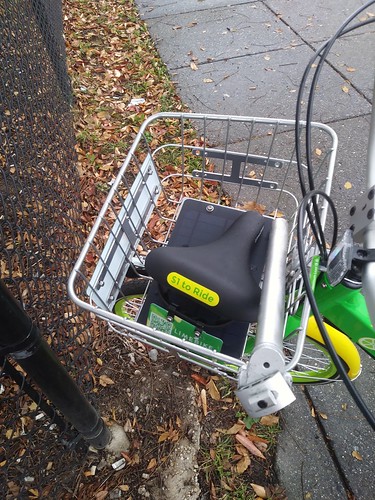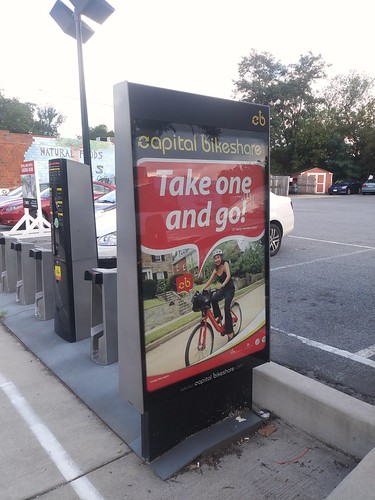Dockless Bikes/Why We Can't Have Nice Things/Ignoring Past Experience
 I know I am beating a dead horse here, as it appears that most of the traditional (non-electric powered) dockless systems that were deployed in the US over the last year seem to be disappearing ("Theft and destruction of dockless bikes a growing problem," Washington Post).
I know I am beating a dead horse here, as it appears that most of the traditional (non-electric powered) dockless systems that were deployed in the US over the last year seem to be disappearing ("Theft and destruction of dockless bikes a growing problem," Washington Post).-- "Bike sharing data from Seattle," June
-- "Maybe New York City just needs to invest in public secure bike parking (re: dockless bike sharing)," April
-- "I finally figured out why mobility services are buying other mobility services: they're acquiring customers already familiar with smart mobility," July
Over the weekend, my brother who lives in South Florida sent me this article, "The bike in the middle of Biscayne Bay: Why we can't have nice things in Miami," from the Miami Herald). It laments that vandalism etc. makes it impossible for dockless bike share to succeed there.
Yes, it does. And everywhere. Even with the very first attempt at bike share in the late 1960s in Amsterdam. After a few weeks, the bikes were all gone, either stolen or wrecked ("How this Amsterdam inventor gave bike-sharing to the world," Guardian).
That's why the response in later iterations was both sound locking systems (second generation, Deutsche Bahn's Call-A-Bike) and later third generation systems with relatively impregnable dock-based systems in Europe with particularly hardy bikes. (I say the "fourth generation" is dock-based systems that are solar powered.)
The dockless systems unleashed over the last year, but previously in China and elsewhere, ignored those lessons. Cheap bikes. Cheap locks pretty much (not for the Jump e-bikes). No docks. In a place like Singapore where crime is taken very seriously, people won't vandalize bikes. That's not the case in major cities in the US or the UK ("Mobike no more: dockless bikes could soon be gone from UK streets," Guardian), or elsewhere.
I am reminded once again of a story told by Olmsted when he was creating Central Park. He was at the garden party of a grandee, who complained to him that the landscaping and accountrements Olmsted was installing in Central Park was nicer than his own garden. Olmsted replied that far more people would be using Central Park and it had to be built hardier in order to withstand all the use it was going to get.
Even systems with higher order checks on use, like Airbnb have had problems with vandalism by "guests" ("$5.3 million home in San Francisco wrecked after Airbnb rental," KGO-TV) to the point where stays now come with $1 million of protection for the property owner (What is the Airbnb Host Guarantee? | Airbnb Help Center).
And it's not like car sharing systems leave the cars unlocked. You go through a driver's license check first, each use must be authorized by the credit card before you have access to the car, there is a hardcore unlocking procedure.
I have zero "sympathy" for the failed dockless bike schemes, because they ignored past experience with "free range" bike sharing. In places where people can vandalize, that small percentage of the population that has that propensity to violence will act it out, wrecking the system for others.
 Although, not all of the problems with the bikes are due to vandalism. The bikes are cheap and break easily, even when not being pushed to the edge.
Although, not all of the problems with the bikes are due to vandalism. The bikes are cheap and break easily, even when not being pushed to the edge.=======
Separately, I've come to believe, at least in the US, that the issue about people not biking for transportation isn't access to bikes. If access had been the issue, then you'd have seen lots of people using the dockless bikes for non-recreational purposes. That wasn't the case.
 Interestingly too, the visibility of the dock stations for bike share might aid as a marketing device, but also as a branding and community building element--potentially, if that aspect is developed by the system.
Interestingly too, the visibility of the dock stations for bike share might aid as a marketing device, but also as a branding and community building element--potentially, if that aspect is developed by the system.I'd figure out a way to encourage "super users" to become brand ambassadors, volunteer trail ranger programs, to expand the user base. In the case of DC, the system grows in membership from year to year but not hugely. Other systems, like Divvy in Chicago, do a lot more marketing and community building.
Labels: bicycle and pedestrian planning, collaborative consumption, mobility as a service (MaaS), sustainable mobility platform, transportation as a service (TaaS)



3 Comments:
I think you have to put the Chinese bike into two contexts -- the social and the financial.
The financial is cheap money and the desperation to move abroad and get away from the Chinese government. Didn't work out so well for them. There is an infrastructure lesson in there.
The social is that while vandalism/breakdown are also a problem is the still functioning Chinese system, they are part of a larger eco-system of delivery and logistics.
That is very popular in China because despite enormous infrastructure investment just moving around can be hard. Did I send you the link to the scooter e-share service in Indonesia? So there are thousands of delivery services in China and bikes are part of that larger world.
In the US, it is pretty easy to move around. NYC is basically the only place as bad as china. DC is easy, just wait until 1 to do a delivery.
Hence why the "uber for gas fillups" may work in China but I have doubts it will ever work in DC.
Pizza delivery is the big exception.
not sure about the scooter delivery link, but Nigel from NZ introduced me to it which is why I added it to the SMP framework.
Good point about the integration into delivery and logistics. There was also the Business Insider article about how many destinations seem to be about 15 minutes from a transit station. (+ I read an interesting article about how in rural areas services have "agents" where they get all the packages and then deliver them, sort of a variant of what Walmart will be doing.)
BUT, the big difference in China is that the price for use is 1/7 to 1/10 the cost of a ride here. A few cents versus $1. That's why traditional dock-based is so much more financially efficacious.
Uber for gas... the Post wrote about it recently, but I read about it in Convenience Store News a couple years ago. It will always be a premium service and for people willing to pay, sure. But yes, no way is it able to scale.
But yes, that is the issue for most of these things. IT/telecommunications services/cloud computing drops the cost of offering such programs and makes it so much easier to create networks of service providers (e.g., ride hailing, home stay, etc.). That still doesn't mean that it will be profitable or able to scale.
But there will always be room for niche services. E.g., have you seen ads for Silvercar? It's an app based car rental program mostly at airports. First it was a partnership with Audi, but then Audi bought it.
====
Crazy analyst report about Tesla, said it's likely to be worth 10x what it is now, because of their control of data, use of an IT operating system instead of "big iron" and how this will convert automobile sales to "software like margins."
What a crock. It's easy to have software like margins on software. Really hard when you have to manufacture something.
... years ago you made the point about transit's killer app being "faster" where it was faster, compared to other modes.
Yes, this is the basic point about sustainable mobility in particularly dense, congested places. Providing you have the right set up.
... I was looking up past entries yesterday and came across one from 4 years ago an article in the WCP that interviewed "experts" on what to do about transit/WMATA and actually Evans and Tregoning had some of the best comments.
Evans' point was that we needed more transit for it to work better, basically more station density like NYC or sort of SF's city-centric system (not BART) or of course, the way it is in the big cities in Europe (and certain cities in Asia).
I think that is true in cities like DC too. It would support more density. Reduce car usage, etc.
But I think maybe something of what is going on is that a greater percentage of people's trips are "shorter" and not within the old "point-to-point" Metrorail footprint so that form of transit doesn't work very well.
Not sure what's going on in buses. A guy who used to work for DDOT and then WMATA on buses lives "near by" (a couple miles) and I knocked on his door in July and we talked for not quite an hour, but even so we didn't come to some general conclusion.
... except that the main arterial routes were the most successful.
... I contacted APTA to see if there has ever been a study of best practices for the best performing bus routes (not BRT) across the country, to see if there are some lessons there, but they never got back to me.
I am planning a big piece on bus service at some point, but again, it'll hone in on bus infrastructure, double deck buses, integrated system, bus priority schemes, etc.
Post a Comment
<< Home